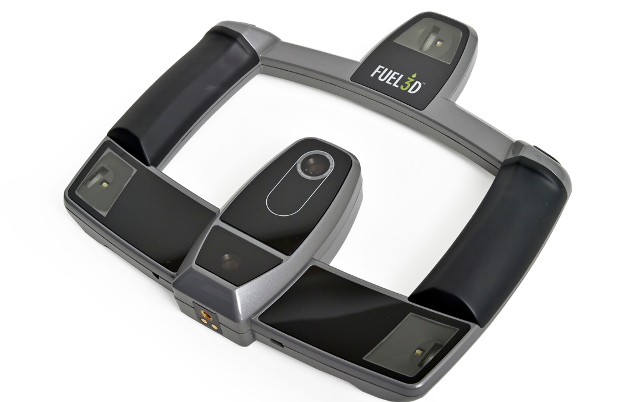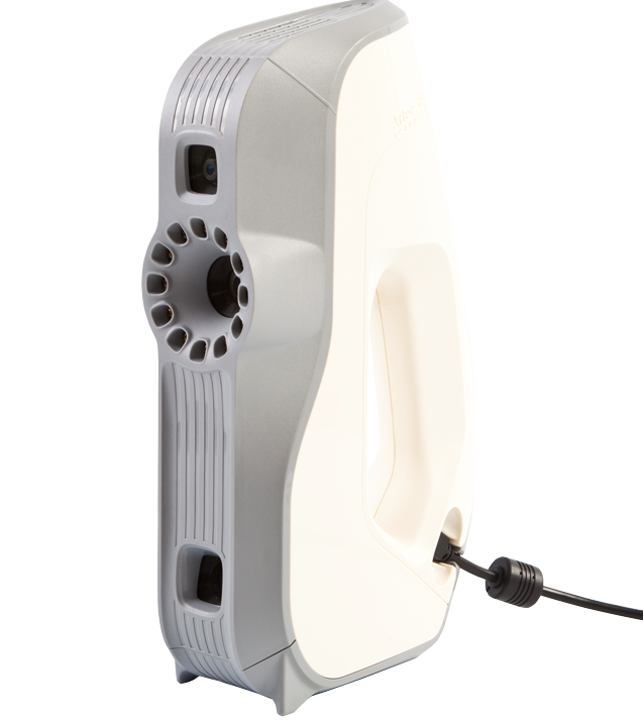
Fuel3D Scanify
Price: £995
Max single scan volume: 210mm x 300mm per capture
Capture rate: 0.1 second per capture, although multiple captures need to be stitched together to produce a full model
Export files: STL, OBJ, PLY
The Fuel3D Scanify was a revelation when it was announced nearly three years ago, due to its industry-shatteringly low price.
Since raising more than $300,000 via a Kickstarter campaign in 2013, the company has gone on to raise millions in private investment. More low-cost options have emerged in that time, yet the Scanify’s output speed and quality is still as eyecatching as ever.
Featuring two 3.5MP cameras and three Xenon flashes, the scanner uses a small positional locator card to fix its 3D scan data in place, rather than the more usual method having to stick dots onto the object.
In a single click it captures all the data in its view – about a 400mm diagonal – and further captures can then be stitched together to capture a full 3D object.
In a workshop this can produce some good results very quickly, although by relying on the flash to capture detail, any material that absorbs or reflects too much light will result in a poor scan.
The device needs to be connected to a computer and power source when in use.
To get around this, an add-on kit has been announced for 2016, costing around $50, which should allow the device to be coupled to a tablet.
The kit will supply a 3D file of a harness that can be adjusted and 3D printed by the user to build a custom coupling to fit any tablet.
Additionally, the scanner software has been redeveloped for 32-bit Windows tablet use.
fuel-3d.com

XYZ Scanner
Price: £199
Max single scan volume: 60cm x 60cm x 30cm
Capture rate: 30fps
Export files: STL, OBJ, PLY
A big player in education markets around the world, XYZ Printing also has a number of products with potential for professional use.
Already offering a desktop 3D printer with a combined internal 3D scanner and turntable, the company has now released a handheld device for more free roaming use.
The XYZ Scanner uses Intel’s compact RealSense technology – the type found in an increasing number of PCs and laptops – using its three lenses to capture regular and infrared images, while the third projects an infrared laser.
As you’d expect from a piece of kit that must fit into increasingly thin devices, the handset is a small, lightweight unit designed for single-handed use. The scanner is self-positioning, meaning no dots or cards, capturing reasonable levels of detail in full-colour within the confines of a set cube.
The device has to be connected directly to a computer via USB, but with a long cable it allows the user to manoeuvre and scan reasonably sized objects.To operate, the running gear needs to be Windows 8.1 or more recent, and with at least a 4th-generation Intel Core Processor for it to work.
We tested it using a laptop, which gave it enough mobility, while the packaged software from XYZ also has a range of basic editing features that allow for scans to be made watertight and corrected on the spot, ready for use.
While the output is never going to challenge the devices in the upper echelons of reality capture, for under £200 this is an unpretentious bit of kit for grabbing basic geometries and digitising them.
eu.xyzprinting.com

3D Systems iSense
Price: £215 (40% off until 2 January 2016)
Max single scan volume: 3m x 3m x 3m
Capture rate: 30fps
Export files: STL, OBJ, PLY
If the thought of the Apple iPhone camera lens not being flush with the case causes you a nervous tick, then having the iSense scanner clamped on your phone is going to be a problem.
Clipping on to a iPhone 6 or 6s handset via 3D printed case, and connecting via a short cable to the phone’s Lightning port, the overall feel is a bit ‘cobbled together’. That said, this is the only truly mobile scanner we’ve tested. Running off the iPhone’s power and using its camera, display and positioning, the device can be used anywhere.
As part of the 3D Systems Cubify range, the iSense is targeted at consumers rather than professionals – think 3D selfies – yet the outcome of this is an easy-to-use workflow through the free iSense app.
The graphical UI translates to ease of use and being able to scan straight away once you have it clipped to the phone.
A few finger swipes allows some basic model editing and watertighting of the shell, with the process designed to send the files straight from the handset to a compatible 3D printer or save them to the cloud.
Calibration of the scanner is done via a separate free app, and capturing data within the set parameters is a bit tricky to get the hang of at first, but otherwise, this is straightforward from the get-go, with useful onscreen guides should you get stuck.
The data output is on par with that of the XYZ Scanner, but its levels of portability and convenience make it very handy to have in a bag should the need to scan something arise.
cubify.com/products/isense

Artec Eva
Price: €13,700
Max single scan volume: N/A
Capture rate: 16fps
Export files: OBJ, PLY, WRL, STL, AOP, ASCII, PTX, E57, XYZRGB
Artec has been shipping its range of 3D scanners for a good long while now. The latest generation of products sees a range that spans from the entry level for the professional (the Artec Eva), up to the allsinging, all-dancing SpaceSpider.
The Artec Eva is a nifty little beast. It’s connected via USB (and a seperate power brick) and its about the size of a 1980s mobile phone.
The cables are long enough to get you where you need to be and the whole device feels very solid indeed – but if you want to keep it static, there’s a standard tripod mount on the base as well.
The Eva will capture your forms at 16 frames per second and get you both the geometry and textures (there is a cheaper non-texture capturing model).
In use, it’s quick and efficient, allowing you to capture either seperate scans in one session (using the on board buttons) or you can switch on the Mesh Fusion functions and have the system do a lot of the donkey work for you.
In terms of resoultion, the Eva works to 0.5mm in terms of resolution, meaning that this machine is really built for larger, organic objects (such as sculptural details), where you’re interested in capturing the form and the texture, rather than hard-core engineering details. Its field of view also backs this up, with a scan area of 214 x 148 mm at its closest range and 536 x 371mm at its furthest.
As with all 3D scanners, much of the power lies not in the capture, but in the post-processing and Artec’s Shape Studio Professional is pretty easy to use once you’ve got your head around registration and mesh clean up.
artec3d.com
Four of the best entry-level 3D scanners
Default






